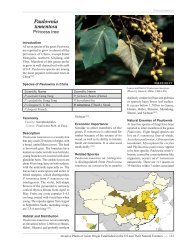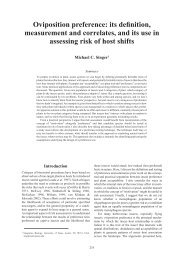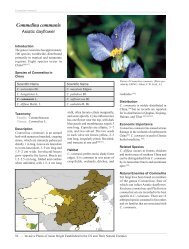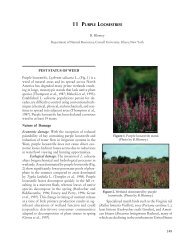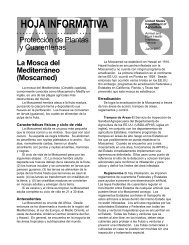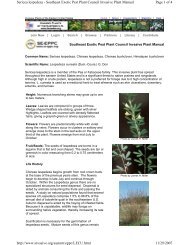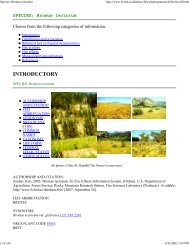A review of literature and field practices focused on ... - Invasive.org
A review of literature and field practices focused on ... - Invasive.org
A review of literature and field practices focused on ... - Invasive.org
You also want an ePaper? Increase the reach of your titles
YUMPU automatically turns print PDFs into web optimized ePapers that Google loves.
Figure 3. Leaves <str<strong>on</strong>g>of</str<strong>on</strong>g> P. sachalinense, P. cuspidatum <str<strong>on</strong>g>and</str<strong>on</strong>g> P. polystachyum (Oreg<strong>on</strong> TNC)<br />
Basic Knotweed Ecology (from Soll, 2004)<br />
In the Pacific Northwest (PNW), at low elevati<strong>on</strong>, knotweed typically starts growth in<br />
April, earlier in warm areas, <str<strong>on</strong>g>and</str<strong>on</strong>g> as late as June at higher elevati<strong>on</strong>s. Even at low<br />
elevati<strong>on</strong>, stems from deeply buried roots may emerge as late as July or August.<br />
Knotweed grows extremely fast during the spring [Emergence reported in March <str<strong>on</strong>g>and</str<strong>on</strong>g><br />
April in Pennsylvania (Gover, 2005) <str<strong>on</strong>g>and</str<strong>on</strong>g> flowering from July <str<strong>on</strong>g>and</str<strong>on</strong>g> September in New<br />
York (Mitchell & Dean, 1978)]. Giant knotweed can reach 15 feet (4.5 meters) by June<br />
(photograph 6). The slightly shorter Japanese knotweed reaches “<strong>on</strong>ly” 10 feet (3 meters)<br />
or so. The “dwarf’ Himalayan variety is shorter still, typically reaching 4-6 feet (1.5 - 2<br />
meters).<br />
Knotweed is a creeping perennial. It dies back to the ground with the first hard frost, <str<strong>on</strong>g>and</str<strong>on</strong>g><br />
returns each spring from the same root system. The term “creeping” refers to the<br />
extensive network <str<strong>on</strong>g>of</str<strong>on</strong>g> rhizomes (roots that can sprout) spreading at least 23 feet (7<br />
meters), <str<strong>on</strong>g>and</str<strong>on</strong>g> possibly as far as 65 feet (20 meters) from the parent plant <str<strong>on</strong>g>and</str<strong>on</strong>g> penetrating at<br />
least 7 feet (2 meters) into the soil.<br />
Knotweed can spread rapidly due to its ability to reproduce vegetatively. Root <str<strong>on</strong>g>and</str<strong>on</strong>g> stem<br />
fragments, as small as 1/2" (1cm) can form new plant col<strong>on</strong>ies. Seas<strong>on</strong>al high water<br />
events <str<strong>on</strong>g>and</str<strong>on</strong>g> floods sweep plants into rivers <str<strong>on</strong>g>and</str<strong>on</strong>g> creeks, then fragment <str<strong>on</strong>g>and</str<strong>on</strong>g> disperse<br />
knotweed plant parts throughout the floodplains <str<strong>on</strong>g>and</str<strong>on</strong>g> cobble bars. The fast growing<br />
knotweed then takes advantage <str<strong>on</strong>g>of</str<strong>on</strong>g> the freshly disturbed soil to become established.<br />
Because it grows faster than most other plant species (including native species <str<strong>on</strong>g>and</str<strong>on</strong>g> most<br />
other weeds) it quickly outgrows <str<strong>on</strong>g>and</str<strong>on</strong>g> suppresses or kills them.<br />
4


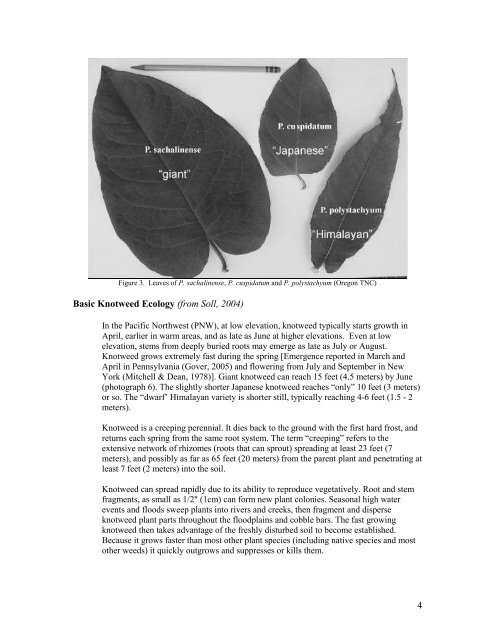

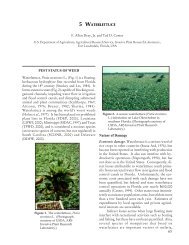

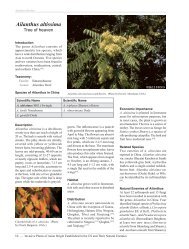
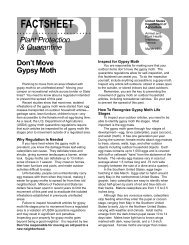
![A Guide to the Control and Management of Invasive Phragmites [PDF]](https://img.yumpu.com/27321025/1/190x190/a-guide-to-the-control-and-management-of-invasive-phragmites-pdf.jpg?quality=85)

